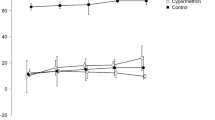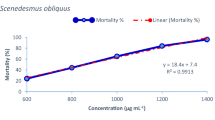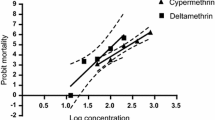Abstract
Pyrethrins I and II were extracted from five seasonal Compositae herbs collected from semi-arid and hilly areas of North India. The relative toxicity of natural pyrethrins were evaluated against Mesocyclops leuckarti sensu lato. Based on the LC50 values, the extract of the plants could be arranged as follows: Tageles minuta > Pulicaria crispa > T. patula > T. minuta > P. angustifolia.
Résumé
Perythrin I et Perythrin II furent extraits de cinq plantes composites collectées dans les regions semi-arides et montagneuses du Nord de l’Inde. La toxicité relative du Perythrin naturel etait evaluée contre le Mesocyclops leuckarti sensu lato. En considerant la valeur du LC50, les extraits de ces plantes peuvent être classifier comme suit: Tagetes minuta > Pulicaria crispa > T. patula > T. minuta > P. angustifolia.
Similar content being viewed by others
References
Anonymous (1982) Opportunities for control of dra-cunculiasis. Report of the Workshop Sponsored by Board of Science & Technology for International Development. “Control Strategies”,pp. 36–52.
Anonymous (1983) Guinea Worm Eradication Programme in India (Operational Manual) National Institute of Communicable Diseases, Delhi, India.
Association of Official Agricultural Chemists (1965) Official Methods of Analysis 10th éd.,pp. 50–52, Assoc. Off. Agric. Chem. Washington, D.C.
Burt P. E. and Goodchild R. E. (1971) Mode of action of pyrethroids Rothamsted Exp. Stn Rep.,pp. 185–187.
Casida J. (1973) Residue and tolerance consideration. In Pyrethrum—The Natural Insecticide (Edited by Casida J. E.), pp. 302, Academic Press, New York.
Finney D. G. (1952) Probit Analysis. Cambridge Univ. Press, Cambridge.
Head S. W. (1973) Composition of pyrethrum extract. In Pyrethrum—The Natural Insecticide (Edited by Casida J. E.),pp. 25–48, Academic Press, New York.
Hobbs J. H. (1976) A trial of ultra-low volume pyrethrin spraying as a malaria control measure in El Salvador. Mosq. News 36, 132–137.
Mehta S., Gupta A. N. and Srivastava R. C (1982) Comparative toxicity of certain non-insecticidal chemicals to Mesocyclops leuckarti—the carrier host of Dra-cunculiasis. Acta Hydrochem. Hydrobiol. 10, 361–365.
Mehta S. and Srivastava R. C (1984) Efficaciousness of certain chemicals to control Dracunculiasis—A field trial. Acta Hydrochem. Hydrobiol. 12, 291–300.
Stahl E. and Pfeifle J. (1966) Thin-layer and gas chromatography of pyrethrum based insecticides. Pyrethrum Post 8.
Verschoyle R. D. and Barnes J. M. (1972) Toxicity of natural and synthetic pyrethrins to rats. Pestic. Biochem. Physiol. 2, 308–311.
Author information
Authors and Affiliations
Rights and permissions
About this article
Cite this article
Kamal, R., Mangla, M., Prakash, D. et al. Relative Toxicity of Natural Pyrethrins against Mesocyclops leuckarti sensu lato—the Carrier of Dracunculiasis. Int J Trop Insect Sci 9, 437–440 (1988). https://doi.org/10.1017/S1742758400010924
Received:
Revised:
Published:
Issue Date:
DOI: https://doi.org/10.1017/S1742758400010924




